Analyzing Entrepreneurial Orientation and Firm Performance Link
VerifiedAdded on 2023/06/15
|8
|1621
|224
Report
AI Summary
This report discusses the elements of Entrepreneurial Orientation (EO) and competitive strategies, focusing on how firms acting as Originalizers, Systematizers, and Evaluators can achieve growth. It analyzes the alignment of competitive strategy with entrepreneurial orientation for long-term success, emphasizing risk-taking, pro-activeness, and innovation as key characteristics of entrepreneurial firms. The report also examines differentiation, cost leadership, and mixed strategies, highlighting the importance of matching competitive strategy with the firm's EO profile. It concludes that firms should adopt competitive strategies that complement their specific entrepreneurial orientation to enhance organizational growth. Desklib provides access to similar reports and study resources for students.
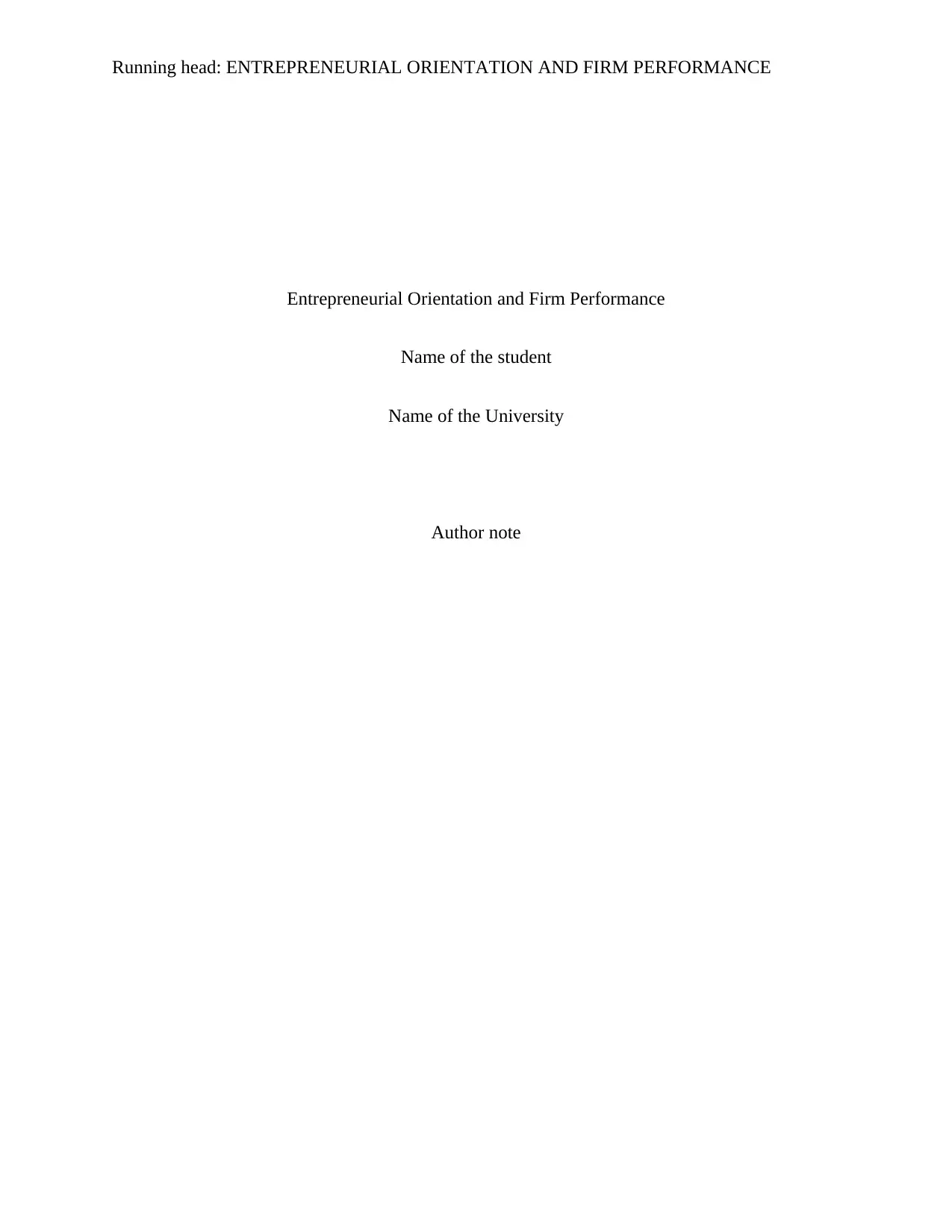
Running head: ENTREPRENEURIAL ORIENTATION AND FIRM PERFORMANCE
Entrepreneurial Orientation and Firm Performance
Name of the student
Name of the University
Author note
Entrepreneurial Orientation and Firm Performance
Name of the student
Name of the University
Author note
Paraphrase This Document
Need a fresh take? Get an instant paraphrase of this document with our AI Paraphraser
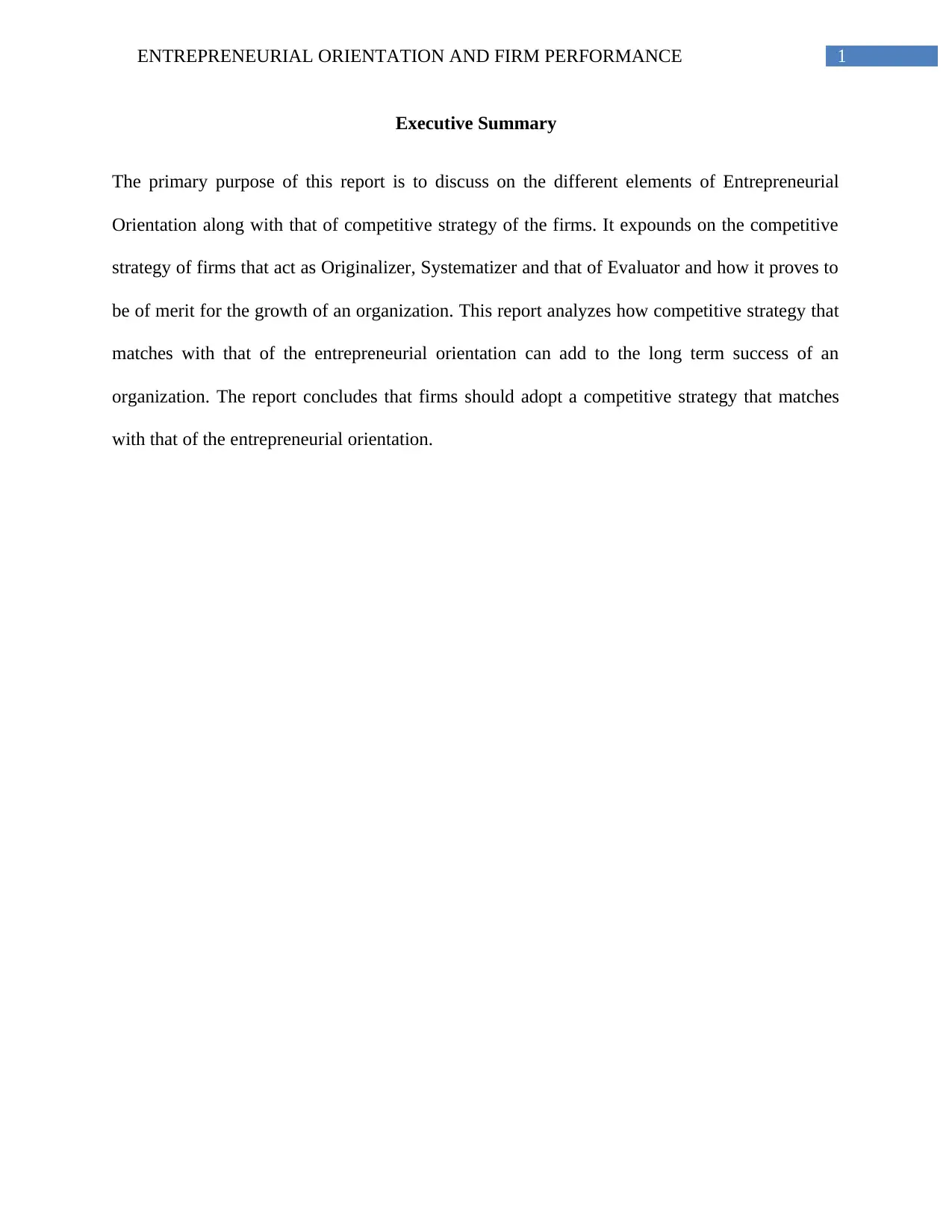
1ENTREPRENEURIAL ORIENTATION AND FIRM PERFORMANCE
Executive Summary
The primary purpose of this report is to discuss on the different elements of Entrepreneurial
Orientation along with that of competitive strategy of the firms. It expounds on the competitive
strategy of firms that act as Originalizer, Systematizer and that of Evaluator and how it proves to
be of merit for the growth of an organization. This report analyzes how competitive strategy that
matches with that of the entrepreneurial orientation can add to the long term success of an
organization. The report concludes that firms should adopt a competitive strategy that matches
with that of the entrepreneurial orientation.
Executive Summary
The primary purpose of this report is to discuss on the different elements of Entrepreneurial
Orientation along with that of competitive strategy of the firms. It expounds on the competitive
strategy of firms that act as Originalizer, Systematizer and that of Evaluator and how it proves to
be of merit for the growth of an organization. This report analyzes how competitive strategy that
matches with that of the entrepreneurial orientation can add to the long term success of an
organization. The report concludes that firms should adopt a competitive strategy that matches
with that of the entrepreneurial orientation.
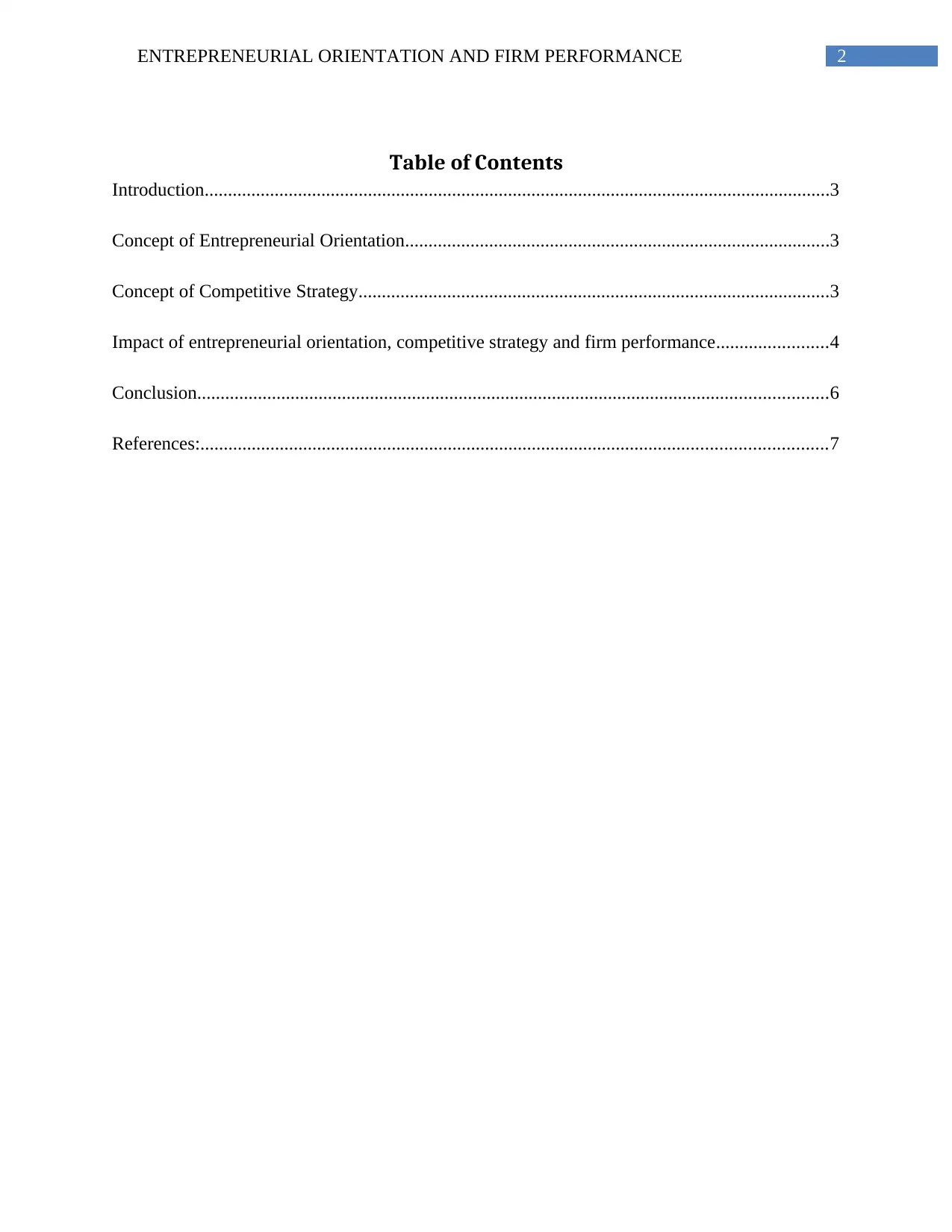
2ENTREPRENEURIAL ORIENTATION AND FIRM PERFORMANCE
Table of Contents
Introduction......................................................................................................................................3
Concept of Entrepreneurial Orientation...........................................................................................3
Concept of Competitive Strategy.....................................................................................................3
Impact of entrepreneurial orientation, competitive strategy and firm performance........................4
Conclusion.......................................................................................................................................6
References:......................................................................................................................................7
Table of Contents
Introduction......................................................................................................................................3
Concept of Entrepreneurial Orientation...........................................................................................3
Concept of Competitive Strategy.....................................................................................................3
Impact of entrepreneurial orientation, competitive strategy and firm performance........................4
Conclusion.......................................................................................................................................6
References:......................................................................................................................................7
⊘ This is a preview!⊘
Do you want full access?
Subscribe today to unlock all pages.

Trusted by 1+ million students worldwide
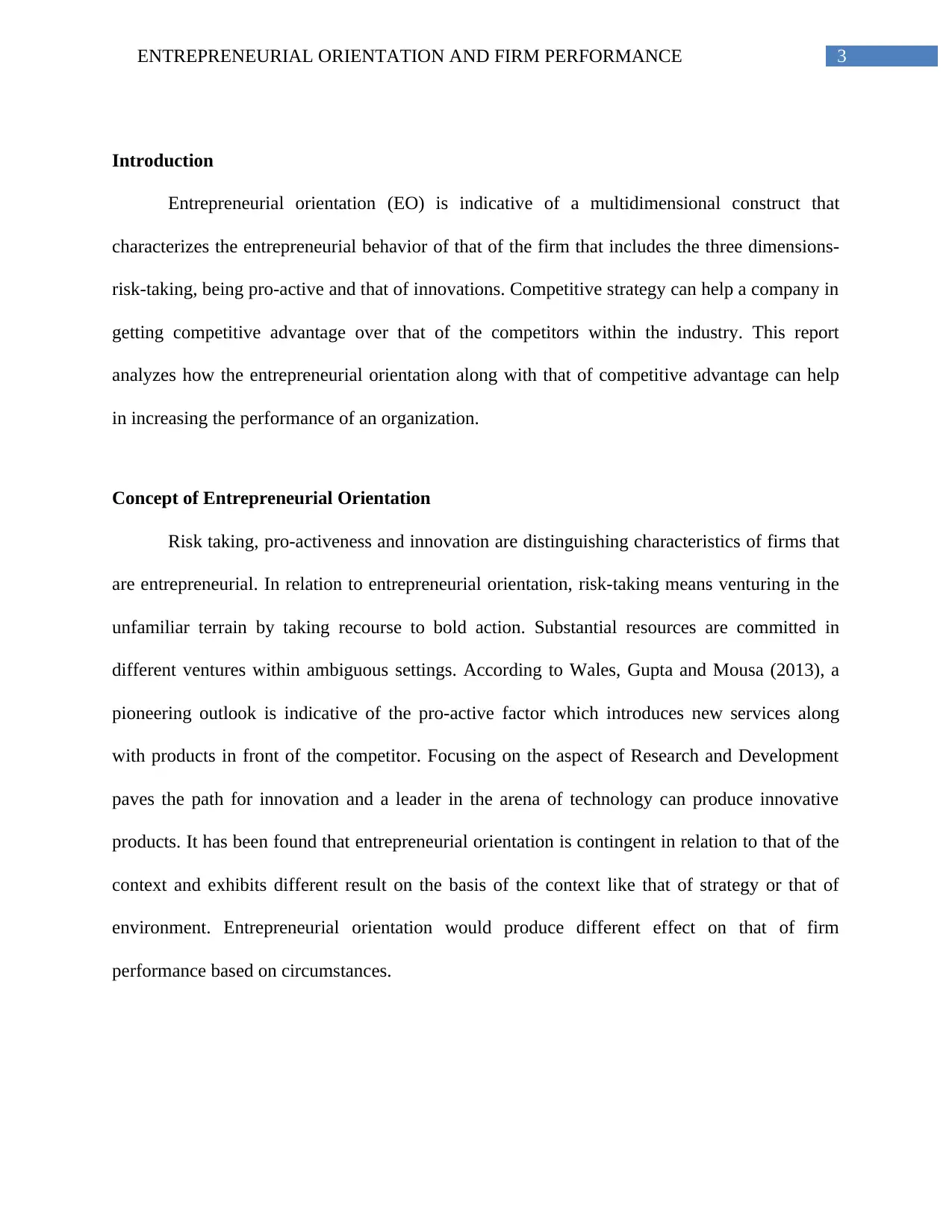
3ENTREPRENEURIAL ORIENTATION AND FIRM PERFORMANCE
Introduction
Entrepreneurial orientation (EO) is indicative of a multidimensional construct that
characterizes the entrepreneurial behavior of that of the firm that includes the three dimensions-
risk-taking, being pro-active and that of innovations. Competitive strategy can help a company in
getting competitive advantage over that of the competitors within the industry. This report
analyzes how the entrepreneurial orientation along with that of competitive advantage can help
in increasing the performance of an organization.
Concept of Entrepreneurial Orientation
Risk taking, pro-activeness and innovation are distinguishing characteristics of firms that
are entrepreneurial. In relation to entrepreneurial orientation, risk-taking means venturing in the
unfamiliar terrain by taking recourse to bold action. Substantial resources are committed in
different ventures within ambiguous settings. According to Wales, Gupta and Mousa (2013), a
pioneering outlook is indicative of the pro-active factor which introduces new services along
with products in front of the competitor. Focusing on the aspect of Research and Development
paves the path for innovation and a leader in the arena of technology can produce innovative
products. It has been found that entrepreneurial orientation is contingent in relation to that of the
context and exhibits different result on the basis of the context like that of strategy or that of
environment. Entrepreneurial orientation would produce different effect on that of firm
performance based on circumstances.
Introduction
Entrepreneurial orientation (EO) is indicative of a multidimensional construct that
characterizes the entrepreneurial behavior of that of the firm that includes the three dimensions-
risk-taking, being pro-active and that of innovations. Competitive strategy can help a company in
getting competitive advantage over that of the competitors within the industry. This report
analyzes how the entrepreneurial orientation along with that of competitive advantage can help
in increasing the performance of an organization.
Concept of Entrepreneurial Orientation
Risk taking, pro-activeness and innovation are distinguishing characteristics of firms that
are entrepreneurial. In relation to entrepreneurial orientation, risk-taking means venturing in the
unfamiliar terrain by taking recourse to bold action. Substantial resources are committed in
different ventures within ambiguous settings. According to Wales, Gupta and Mousa (2013), a
pioneering outlook is indicative of the pro-active factor which introduces new services along
with products in front of the competitor. Focusing on the aspect of Research and Development
paves the path for innovation and a leader in the arena of technology can produce innovative
products. It has been found that entrepreneurial orientation is contingent in relation to that of the
context and exhibits different result on the basis of the context like that of strategy or that of
environment. Entrepreneurial orientation would produce different effect on that of firm
performance based on circumstances.
Paraphrase This Document
Need a fresh take? Get an instant paraphrase of this document with our AI Paraphraser
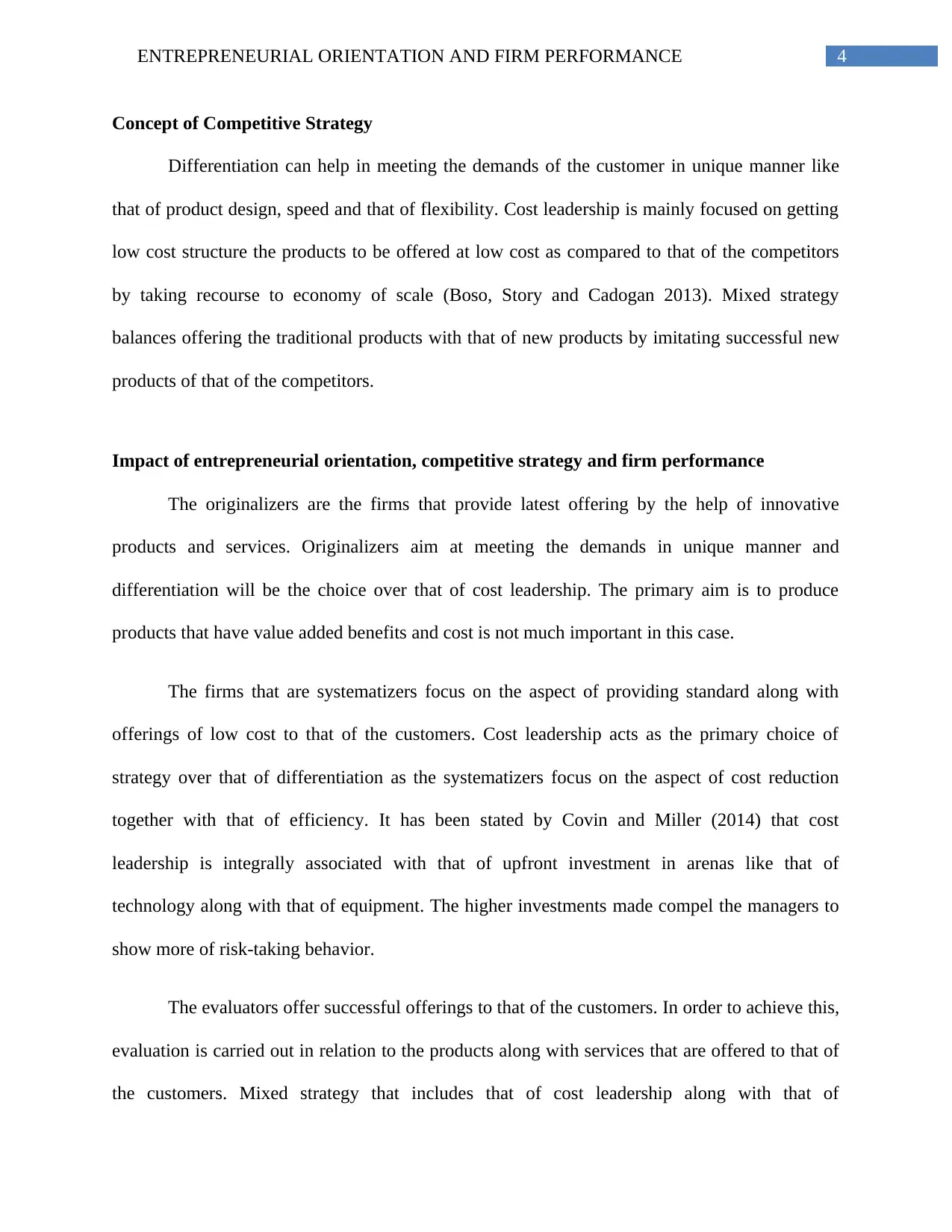
4ENTREPRENEURIAL ORIENTATION AND FIRM PERFORMANCE
Concept of Competitive Strategy
Differentiation can help in meeting the demands of the customer in unique manner like
that of product design, speed and that of flexibility. Cost leadership is mainly focused on getting
low cost structure the products to be offered at low cost as compared to that of the competitors
by taking recourse to economy of scale (Boso, Story and Cadogan 2013). Mixed strategy
balances offering the traditional products with that of new products by imitating successful new
products of that of the competitors.
Impact of entrepreneurial orientation, competitive strategy and firm performance
The originalizers are the firms that provide latest offering by the help of innovative
products and services. Originalizers aim at meeting the demands in unique manner and
differentiation will be the choice over that of cost leadership. The primary aim is to produce
products that have value added benefits and cost is not much important in this case.
The firms that are systematizers focus on the aspect of providing standard along with
offerings of low cost to that of the customers. Cost leadership acts as the primary choice of
strategy over that of differentiation as the systematizers focus on the aspect of cost reduction
together with that of efficiency. It has been stated by Covin and Miller (2014) that cost
leadership is integrally associated with that of upfront investment in arenas like that of
technology along with that of equipment. The higher investments made compel the managers to
show more of risk-taking behavior.
The evaluators offer successful offerings to that of the customers. In order to achieve this,
evaluation is carried out in relation to the products along with services that are offered to that of
the customers. Mixed strategy that includes that of cost leadership along with that of
Concept of Competitive Strategy
Differentiation can help in meeting the demands of the customer in unique manner like
that of product design, speed and that of flexibility. Cost leadership is mainly focused on getting
low cost structure the products to be offered at low cost as compared to that of the competitors
by taking recourse to economy of scale (Boso, Story and Cadogan 2013). Mixed strategy
balances offering the traditional products with that of new products by imitating successful new
products of that of the competitors.
Impact of entrepreneurial orientation, competitive strategy and firm performance
The originalizers are the firms that provide latest offering by the help of innovative
products and services. Originalizers aim at meeting the demands in unique manner and
differentiation will be the choice over that of cost leadership. The primary aim is to produce
products that have value added benefits and cost is not much important in this case.
The firms that are systematizers focus on the aspect of providing standard along with
offerings of low cost to that of the customers. Cost leadership acts as the primary choice of
strategy over that of differentiation as the systematizers focus on the aspect of cost reduction
together with that of efficiency. It has been stated by Covin and Miller (2014) that cost
leadership is integrally associated with that of upfront investment in arenas like that of
technology along with that of equipment. The higher investments made compel the managers to
show more of risk-taking behavior.
The evaluators offer successful offerings to that of the customers. In order to achieve this,
evaluation is carried out in relation to the products along with services that are offered to that of
the customers. Mixed strategy that includes that of cost leadership along with that of
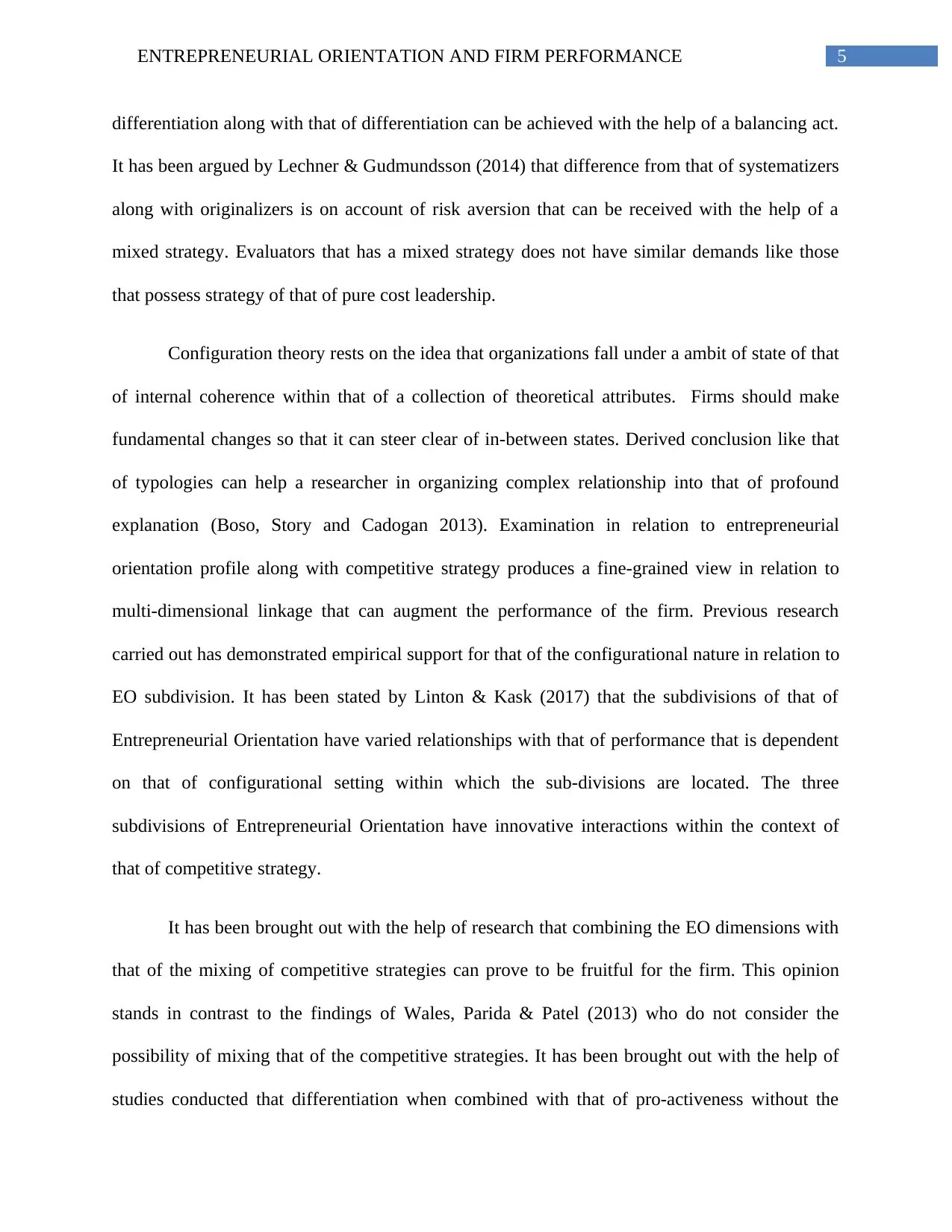
5ENTREPRENEURIAL ORIENTATION AND FIRM PERFORMANCE
differentiation along with that of differentiation can be achieved with the help of a balancing act.
It has been argued by Lechner & Gudmundsson (2014) that difference from that of systematizers
along with originalizers is on account of risk aversion that can be received with the help of a
mixed strategy. Evaluators that has a mixed strategy does not have similar demands like those
that possess strategy of that of pure cost leadership.
Configuration theory rests on the idea that organizations fall under a ambit of state of that
of internal coherence within that of a collection of theoretical attributes. Firms should make
fundamental changes so that it can steer clear of in-between states. Derived conclusion like that
of typologies can help a researcher in organizing complex relationship into that of profound
explanation (Boso, Story and Cadogan 2013). Examination in relation to entrepreneurial
orientation profile along with competitive strategy produces a fine-grained view in relation to
multi-dimensional linkage that can augment the performance of the firm. Previous research
carried out has demonstrated empirical support for that of the configurational nature in relation to
EO subdivision. It has been stated by Linton & Kask (2017) that the subdivisions of that of
Entrepreneurial Orientation have varied relationships with that of performance that is dependent
on that of configurational setting within which the sub-divisions are located. The three
subdivisions of Entrepreneurial Orientation have innovative interactions within the context of
that of competitive strategy.
It has been brought out with the help of research that combining the EO dimensions with
that of the mixing of competitive strategies can prove to be fruitful for the firm. This opinion
stands in contrast to the findings of Wales, Parida & Patel (2013) who do not consider the
possibility of mixing that of the competitive strategies. It has been brought out with the help of
studies conducted that differentiation when combined with that of pro-activeness without the
differentiation along with that of differentiation can be achieved with the help of a balancing act.
It has been argued by Lechner & Gudmundsson (2014) that difference from that of systematizers
along with originalizers is on account of risk aversion that can be received with the help of a
mixed strategy. Evaluators that has a mixed strategy does not have similar demands like those
that possess strategy of that of pure cost leadership.
Configuration theory rests on the idea that organizations fall under a ambit of state of that
of internal coherence within that of a collection of theoretical attributes. Firms should make
fundamental changes so that it can steer clear of in-between states. Derived conclusion like that
of typologies can help a researcher in organizing complex relationship into that of profound
explanation (Boso, Story and Cadogan 2013). Examination in relation to entrepreneurial
orientation profile along with competitive strategy produces a fine-grained view in relation to
multi-dimensional linkage that can augment the performance of the firm. Previous research
carried out has demonstrated empirical support for that of the configurational nature in relation to
EO subdivision. It has been stated by Linton & Kask (2017) that the subdivisions of that of
Entrepreneurial Orientation have varied relationships with that of performance that is dependent
on that of configurational setting within which the sub-divisions are located. The three
subdivisions of Entrepreneurial Orientation have innovative interactions within the context of
that of competitive strategy.
It has been brought out with the help of research that combining the EO dimensions with
that of the mixing of competitive strategies can prove to be fruitful for the firm. This opinion
stands in contrast to the findings of Wales, Parida & Patel (2013) who do not consider the
possibility of mixing that of the competitive strategies. It has been brought out with the help of
studies conducted that differentiation when combined with that of pro-activeness without the
⊘ This is a preview!⊘
Do you want full access?
Subscribe today to unlock all pages.

Trusted by 1+ million students worldwide
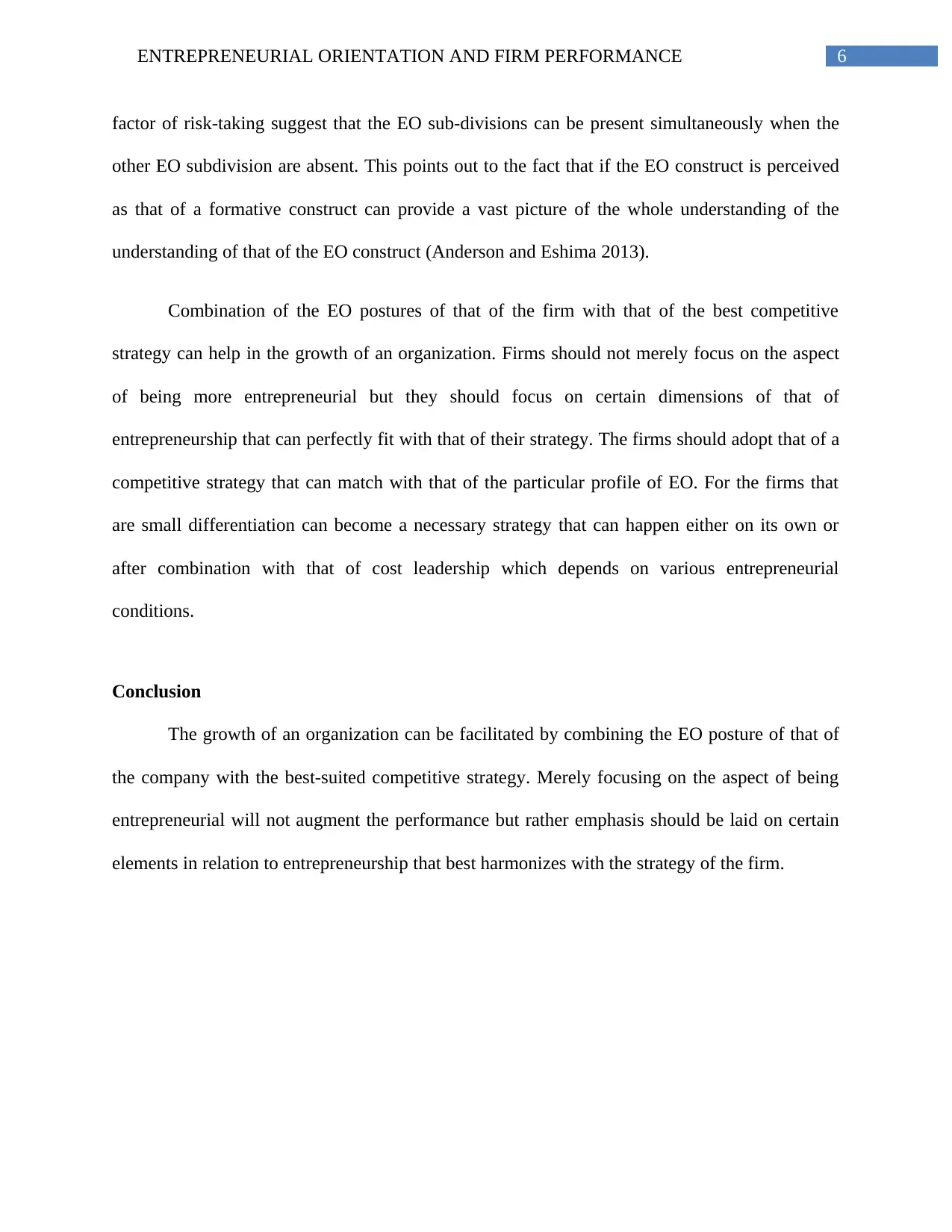
6ENTREPRENEURIAL ORIENTATION AND FIRM PERFORMANCE
factor of risk-taking suggest that the EO sub-divisions can be present simultaneously when the
other EO subdivision are absent. This points out to the fact that if the EO construct is perceived
as that of a formative construct can provide a vast picture of the whole understanding of the
understanding of that of the EO construct (Anderson and Eshima 2013).
Combination of the EO postures of that of the firm with that of the best competitive
strategy can help in the growth of an organization. Firms should not merely focus on the aspect
of being more entrepreneurial but they should focus on certain dimensions of that of
entrepreneurship that can perfectly fit with that of their strategy. The firms should adopt that of a
competitive strategy that can match with that of the particular profile of EO. For the firms that
are small differentiation can become a necessary strategy that can happen either on its own or
after combination with that of cost leadership which depends on various entrepreneurial
conditions.
Conclusion
The growth of an organization can be facilitated by combining the EO posture of that of
the company with the best-suited competitive strategy. Merely focusing on the aspect of being
entrepreneurial will not augment the performance but rather emphasis should be laid on certain
elements in relation to entrepreneurship that best harmonizes with the strategy of the firm.
factor of risk-taking suggest that the EO sub-divisions can be present simultaneously when the
other EO subdivision are absent. This points out to the fact that if the EO construct is perceived
as that of a formative construct can provide a vast picture of the whole understanding of the
understanding of that of the EO construct (Anderson and Eshima 2013).
Combination of the EO postures of that of the firm with that of the best competitive
strategy can help in the growth of an organization. Firms should not merely focus on the aspect
of being more entrepreneurial but they should focus on certain dimensions of that of
entrepreneurship that can perfectly fit with that of their strategy. The firms should adopt that of a
competitive strategy that can match with that of the particular profile of EO. For the firms that
are small differentiation can become a necessary strategy that can happen either on its own or
after combination with that of cost leadership which depends on various entrepreneurial
conditions.
Conclusion
The growth of an organization can be facilitated by combining the EO posture of that of
the company with the best-suited competitive strategy. Merely focusing on the aspect of being
entrepreneurial will not augment the performance but rather emphasis should be laid on certain
elements in relation to entrepreneurship that best harmonizes with the strategy of the firm.
Paraphrase This Document
Need a fresh take? Get an instant paraphrase of this document with our AI Paraphraser
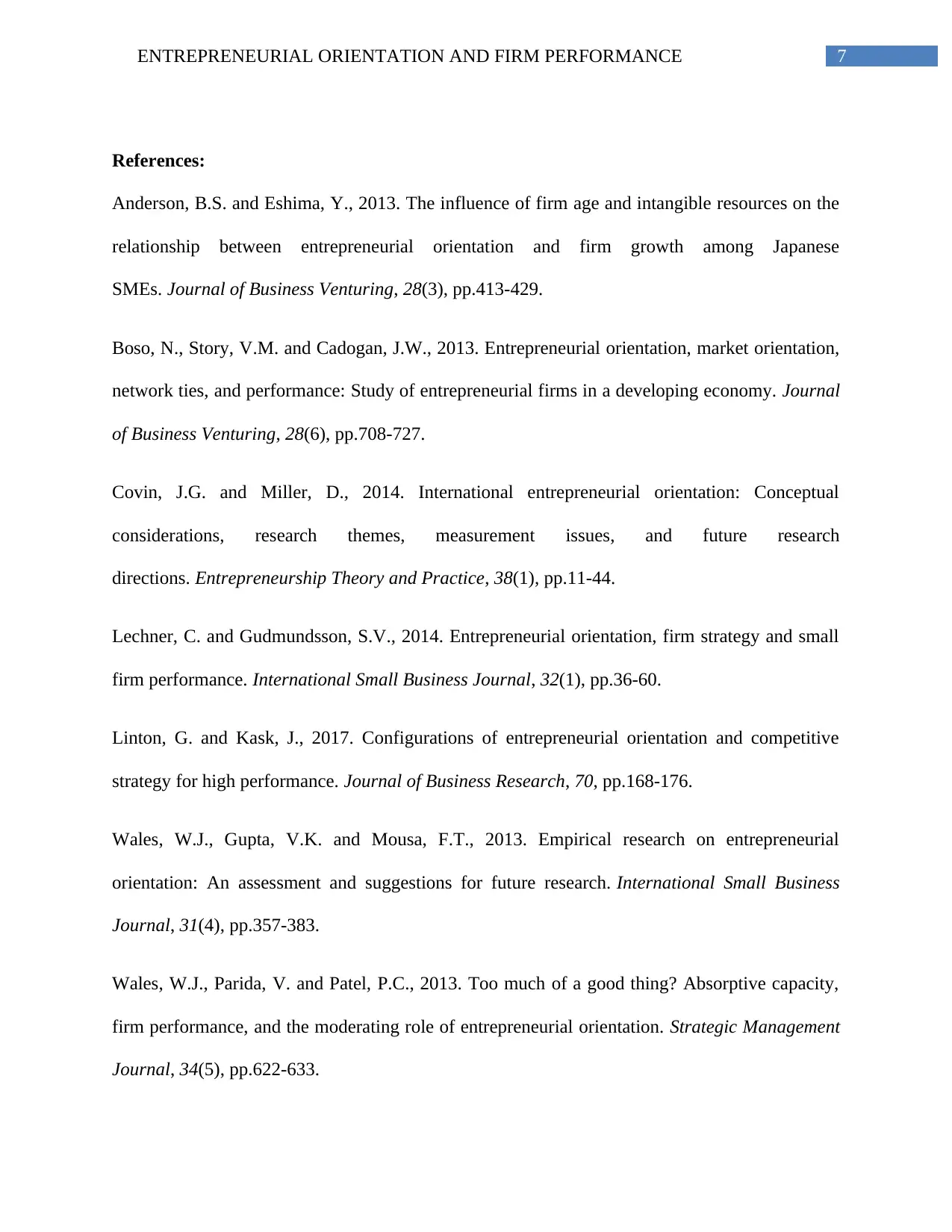
7ENTREPRENEURIAL ORIENTATION AND FIRM PERFORMANCE
References:
Anderson, B.S. and Eshima, Y., 2013. The influence of firm age and intangible resources on the
relationship between entrepreneurial orientation and firm growth among Japanese
SMEs. Journal of Business Venturing, 28(3), pp.413-429.
Boso, N., Story, V.M. and Cadogan, J.W., 2013. Entrepreneurial orientation, market orientation,
network ties, and performance: Study of entrepreneurial firms in a developing economy. Journal
of Business Venturing, 28(6), pp.708-727.
Covin, J.G. and Miller, D., 2014. International entrepreneurial orientation: Conceptual
considerations, research themes, measurement issues, and future research
directions. Entrepreneurship Theory and Practice, 38(1), pp.11-44.
Lechner, C. and Gudmundsson, S.V., 2014. Entrepreneurial orientation, firm strategy and small
firm performance. International Small Business Journal, 32(1), pp.36-60.
Linton, G. and Kask, J., 2017. Configurations of entrepreneurial orientation and competitive
strategy for high performance. Journal of Business Research, 70, pp.168-176.
Wales, W.J., Gupta, V.K. and Mousa, F.T., 2013. Empirical research on entrepreneurial
orientation: An assessment and suggestions for future research. International Small Business
Journal, 31(4), pp.357-383.
Wales, W.J., Parida, V. and Patel, P.C., 2013. Too much of a good thing? Absorptive capacity,
firm performance, and the moderating role of entrepreneurial orientation. Strategic Management
Journal, 34(5), pp.622-633.
References:
Anderson, B.S. and Eshima, Y., 2013. The influence of firm age and intangible resources on the
relationship between entrepreneurial orientation and firm growth among Japanese
SMEs. Journal of Business Venturing, 28(3), pp.413-429.
Boso, N., Story, V.M. and Cadogan, J.W., 2013. Entrepreneurial orientation, market orientation,
network ties, and performance: Study of entrepreneurial firms in a developing economy. Journal
of Business Venturing, 28(6), pp.708-727.
Covin, J.G. and Miller, D., 2014. International entrepreneurial orientation: Conceptual
considerations, research themes, measurement issues, and future research
directions. Entrepreneurship Theory and Practice, 38(1), pp.11-44.
Lechner, C. and Gudmundsson, S.V., 2014. Entrepreneurial orientation, firm strategy and small
firm performance. International Small Business Journal, 32(1), pp.36-60.
Linton, G. and Kask, J., 2017. Configurations of entrepreneurial orientation and competitive
strategy for high performance. Journal of Business Research, 70, pp.168-176.
Wales, W.J., Gupta, V.K. and Mousa, F.T., 2013. Empirical research on entrepreneurial
orientation: An assessment and suggestions for future research. International Small Business
Journal, 31(4), pp.357-383.
Wales, W.J., Parida, V. and Patel, P.C., 2013. Too much of a good thing? Absorptive capacity,
firm performance, and the moderating role of entrepreneurial orientation. Strategic Management
Journal, 34(5), pp.622-633.
1 out of 8
Related Documents
Your All-in-One AI-Powered Toolkit for Academic Success.
+13062052269
info@desklib.com
Available 24*7 on WhatsApp / Email
![[object Object]](/_next/static/media/star-bottom.7253800d.svg)
Unlock your academic potential
Copyright © 2020–2025 A2Z Services. All Rights Reserved. Developed and managed by ZUCOL.




